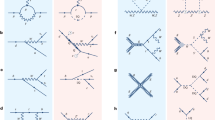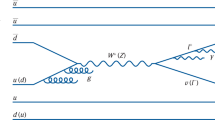Abstract
Over the past quarter of a century, experiments at high-energy particle colliders have established the standard model as the precise theory of particle interactions up to the 100 GeV scale. A series of important experimental discoveries and measurements have filled in most of the missing pieces and tested the predictions of the standard model with great precision.
This is a preview of subscription content, access via your institution
Access options
Subscribe to this journal
Receive 51 print issues and online access
$199.00 per year
only $3.90 per issue
Buy this article
- Purchase on Springer Link
- Instant access to full article PDF
Prices may be subject to local taxes which are calculated during checkout








Similar content being viewed by others
References
Arnison, G. et al. (UA1 Collaboration). Experimental observation of isolated large transverse energy electrons with associated missing energy at √s = 540 GeV. Phys. Lett. B 122, 103–116 (1983).
Banner, M. et al. (UA2 Collaboration). Observation of single isolated electrons of high transverse momentum in events with missing transverse energy at the CERN p̄p collider. Phys. Lett. B 122, 476–485 (1983).
Arnison, G. et al. (UA1 Collaboration). Experimental observation of lepton pairs of invariant mass around 95 GeV/c2 at the CERN SPS collider. Phys. Lett. B 126, 398–410 (1983).
Bagnaia, P. et al. (UA2 Collaboration). Evidence for Z0→ e+e− at the CERN p collider. Phys. Lett. B 129, 130–140 (1983).
Kodama, K. et al. (DONUT Collaboration). Observation of tau neutrino interactions. Phys. Lett. B 504, 218–224 (2001).
Abachi, S. et al. (DØ Collaboration). Top quark search with the DØ 1992–1993 data sample. Phys. Rev. D 52, 4877–4919 (1995).
Abachi, S. et al. (DØ Collaboration). Search for the top quark in pp̄ collisions at √s = 1.8 TeV Phys. Rev. Lett. 72, 2138–2142 (1994).
Abe, F. et al. (CDF Collaboration). Observation of top quark production in pp̄ collisions with the collider detector at Fermilab. Phys. Rev. Lett. 74, 2626–2631 (1995).
Abachi, S. et al. (DØ Collaboration). Observation of the top quark. Phys. Rev. Lett. 74, 2632–2637 (1995).
LEP Electroweak Working Group. LEP Electroweak Working Group. <http://lepewwg.web.cern.ch/LEPEWWG/> (2007).
ALEPH Collaboration, DELPHI Collaborations, L3 Collaboration, OPAL Collaboration and The LEP Working Group for Higgs Boson Searches. Search for the standard model Higgs boson at LEP. Phys. Lett. B 565, 61–75 (2003).
ALEPH, DELPHI, L3, OPAL, SLD collaborations, LEP Electroweak Working Group, the SLD Electroweak and Heavy Flavour Groups. Precision electroweak measurements on the Z resonance. Phys. Rep. 427, 257–454 (2006).
Jones, R. W. L. Final αs combinations from the LEP QCD working group. Nucl. Phys. B Proc. (suppl.) 152, 15–22 (2006).
The LEP Collaborations: ALEPH Collaboration, DELPHI Collaboration, L3 Collaboration, OPAL Collaboration, the LEP Electroweak Working Group. A combination of preliminary electroweak measurements and constraints on the standard model. Preprint at <http://arxiv.org/abs/hep-ex/0612034> (2006).
Tevatron Electroweak Working Group (for the CDF and DØ Collaborations). A combination of CDF and DØ results on the mass of the top quark. Preprint at <http://arxiv.org/abs/hep-ex/0703034v1> (2007).
Quadt, A. Top quark physics at hadron colliders. Eur. Phys. J. C 48, 835–1000 (2006)
Abulencia, A. et al. (CDF Collaboration). Observation of WZ production. Preprint at <http://arxiv.org/abs/hep-ex/0702027>.
CDF Collaboration. Evidence for ZZ production in p̄p at √s = 1.96 TeV. CDF Note 8775 (preliminary). <http://fcdfwww.fnal.gov/physics/ewk/2007/ZZ/ZZ_comb_public_note.ps>.
Abazov, V. M. et al. (DØ Collaboration). Evidence for production of single top quarks and first direct measurement of |Vtb|. Phys. Rev. Lett. 98, 181802 (2007).
Author information
Authors and Affiliations
Ethics declarations
Competing interests
The author declares no competing financial interests.
Additional information
Reprints and permissions information is available at npg.nature.com/reprintsandpermissions.
Correspondence should be addressed to T.W. (twyatt@fnal.gov; Terry.Wyatt@manchester.ac.uk).
Rights and permissions
About this article
Cite this article
Wyatt, T. High-energy colliders and the rise of the standard model. Nature 448, 274–280 (2007). https://doi.org/10.1038/nature06075
Published:
Issue Date:
DOI: https://doi.org/10.1038/nature06075
This article is cited by
Comments
By submitting a comment you agree to abide by our Terms and Community Guidelines. If you find something abusive or that does not comply with our terms or guidelines please flag it as inappropriate.



